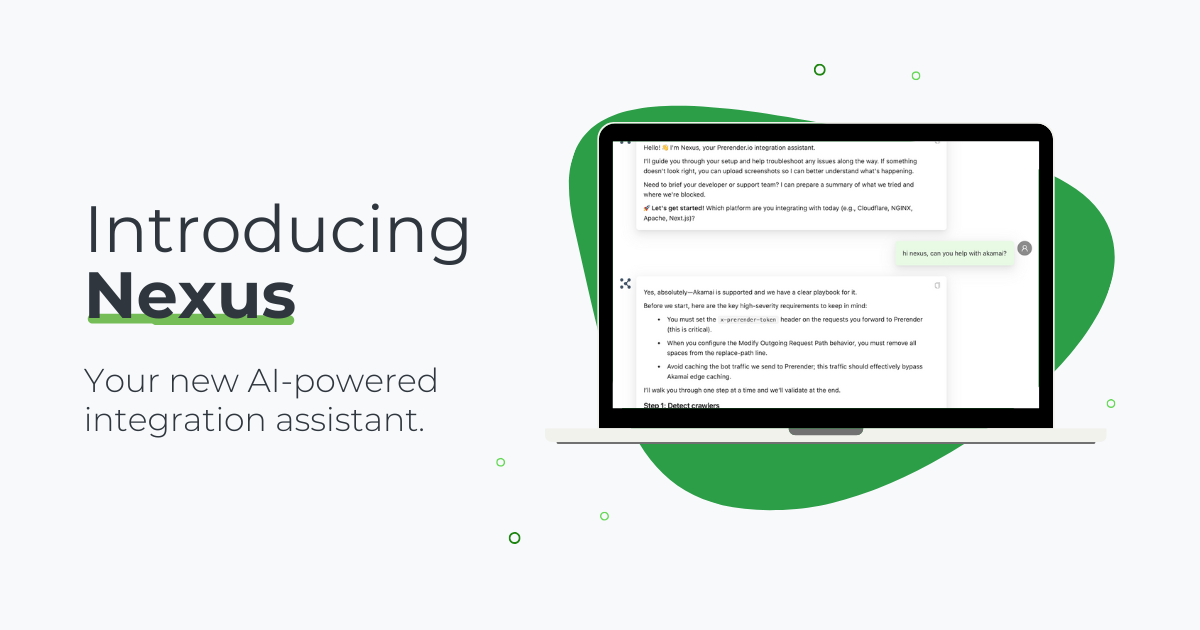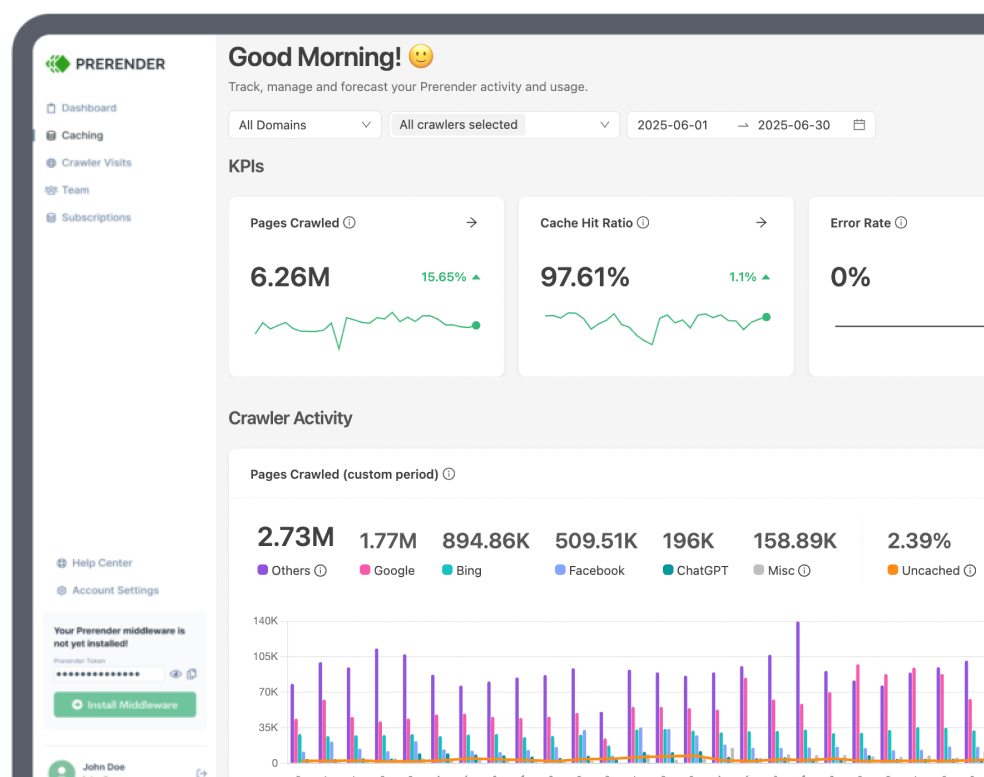JavaScript-heavy websites often struggle with indexing issues, limiting their SEO performance and visibility on AI-powered search platforms. To address these challenges, businesses typically choose between implementing a Prerender.io JavaScript rendering solution or building a custom SEO rendering workflow using Puppeteer.
While Puppeteer provides full control over headless browser rendering and caching, it requires significant resources, ongoing maintenance, and engineering effort. Prerender.io, on the other hand, simplifies prerendering by handling rendering, caching, and crawler detection automatically, removing technical overhead and reducing the risk of indexing errors.
In this Puppeteer vs. Prerender.io comparison, we’ll break down how each solution handles JavaScript rendering and caching, setup, maintenance, and scalability. This guide will help you determine which prerendering tool best supports web performance optimization and boosts visibility across LLM, AI, and traditional search results.
TL;DR of Puppeteer vs. Prerender.io for JavaScript Rendering Solution
|
Aspect |
Puppeteer |
Prerender.io |
|
What it is |
Google’s open-source JS rendering tool |
Managed JavaScript rendering service |
|
Setup effort |
Build a custom rendering pipeline (routing, waits, error handling, caching) |
Plug-and-play via middleware/reverse proxy, compatible with popular JS frameworks and web infrastructures |
|
Setup time |
Days to months, depending on the developer team’s skills and rendering customizations |
Hours to a day, depending on website infrastructure and size |
|
How it works |
You set up bot detection, routing, caching, and HTML sanitization |
Automatically detects search engine and AI bots and serves the prerendered version of your JS content |
|
Control and customization |
Fully customizable |
Rich customization options |
|
Who runs the servers |
Businesses manage browsers, queues, cache, and scaling |
Prerender.io handles all technical setup and infrastructure |
|
Social link previews |
Works if waits and caching are configured correctly |
Ensures social link previews render correctly by default |
|
AI and LLM crawlers |
Works if the correct user-agents are routed manually |
Supports major AI and LLM bots, improving visibility for AI search platforms |
|
Speed and resources |
Headless Chrome can be resource-intensive; careful limits are required |
Heavy lifting is handled by the service; cached pages are served quickly |
How Puppeteer and Prerender.io Compare
What is Puppeteer, and what are its JS Rendering Capabilities?
Puppeteer is Google’s open-source Node.js library that controls headless Chrome browsers or Chromium. It allows developers to programmatically render JavaScript-heavy pages by launching a browser instance, navigating to URLs, waiting for scripts to execute, and extracting the resulting HTML.
Because Puppeteer operates through custom scripts, it gives websites full control over every step of the rendering process. This makes it powerful for businesses that require granular control, but also more complex to scale and maintain.
How does Prerender.io JavaScript Rendering Solution Work?
Prerender.io offers the same core functionality as Puppeteer: it renders your JavaScript content into its HTML version. It’s purpose-built to improve JavaScript SEO and content indexability for single-page applications (SPAs) and other JavaScript-heavy websites such as ecommerce platforms, SaaS products, and i-gaming websites.
Additionally, Prerender.io implements a dynamic rendering solution that can automatically detect requests. Search engine bots and AI crawlers are served with the pre-rendered HTML pages, and human visitors continue to receive your standard JavaScript application.
Prerender.io is a managed service. All you have to do is implement them in your JS-based tech stack, requiring minimum technical knowledge or help from the developer team.
Watch this video for a quick explainer of how Prerender.io improves your site’s visibility and solves JS SEO issues.
Puppeteer vs. Prerender.io JS Rendering: What’s the Difference?
The fundamental difference between Puppeteer vs. Prerender.io lies in their approach: Puppeteer requires a DIY infrastructure, while Prerender.io is a ready-to-use service.
Puppeteer requires building a custom JS rendering system from scratch. This includes the development and server-side setup, such as setting up a dedicated rendering server and logic for bot detection, caching, and serving workflow.
On the other hand, Prerender.io is a plug-and-play JS rendering tool. It is compatible with popular JS frameworks and requires almost no maintenance. Because of this, for businesses that don’t have a developer team to support, Prerender.io is often the go-to choice to solve content invisibility issues caused by JavaScript content. The installation process is simple (only takes three steps)—and many users can see the uptick in crawl performance and faster indexing in a couple of days after implementation.
Both Prerender.io and Puppeteer address JavaScript rendering content challenges, but implementation and maintenance complexity vary dramatically between the two tools.
Puppeteer vs. Prerender.io: Setup and Implementation
Prerender.io: End-to-End JavaScript Rendering Solution
Prerender.io delivers production-ready prerender JavaScript rendering in under one day. The setup process requires three straightforward steps: account creation, middleware installation, and cache configuration.
Integrating Prerender.io with Express.js integration only requires one line of code: app.use(require(‘prerender-node’).set(‘prerenderToken’, ‘YOUR_TOKEN’)). See this list for more integration options.
Once installed, the middleware automatically detects crawler user-agents and serves pre-rendered HTML to bots while regular visitors see the live SPA version. This approach ensures your JavaScript-heavy content is fully indexable without compromising performance or user experience.
You can also customize your Prerender.io setup to handle different bots with precision. For example, you can configure how Prerender.io serves major crawlers like Googlebot, Bingbot, GPTBot, ClaudeBot, or even less common ones like DuckDuckBot. Doing so ensures every relevant crawler receives the correct HTML snapshot of your JavaScript content, enhancing search engine crawlability and LLM visibility. You can view the full list of Prerender.io supported bots here.

Prerender.io supports all major front-end frameworks, React, Angular, Vue, and Ember, without any code changes. Acting as a transparent proxy, it seamlessly integrates with existing deployment workflows, making it one of the most low-maintenance prerendering tools available.
Puppeteer: Complex Headless Browser Rendering Implementation
By contrast, self-hosting Puppeteer introduces considerable setup and maintenance overhead. The initial installation downloads a ~280MB Chrome binary via npm, but preparing it for production involves complex system dependencies and configuration.
For example, deploying Puppeteer on Linux requires installing over 30 packages (such as ca-certificates, libappindicator3-1, and libasound2). Docker environments demand special –no-sandbox flags, fine-tuned memory settings, and strict monitoring. A fully production-ready Puppeteer stack, with caching, error handling, and scaling, typically requires 4–8 weeks of engineering effort.
While Puppeteer offers powerful APIs like launch(), goto(), and content(), real-world implementations go far beyond these basics. Teams must manage Chrome DevTools Protocol connections, browser lifecycle management, and crawler detection logic manually. Without these systems in place, your SEO rendering solution can become unstable or resource-intensive.
Summary:
- Prerender.io offers a low-maintenance JavaScript rendering solution with automatic crawler detection, framework support, and optional customization for search engine and AI bots, ensuring consistent indexing and LLM visibility.
- Puppeteer is highly customizable but requires extensive setup, manual crawler management, and ongoing maintenance, with production deployment typically taking several weeks of engineering effort.
Puppeteer vs. Prerender.io: Maintenance and Overhead Considerations
Prerender.io: Minimal Maintenance, Maximum Reliability
As a fully managed service, Prerender.io removes the ongoing maintenance burden from your team. Its operations team handles global cache infrastructure, monitors rendering performance, and ensures 99.99% uptime across all regions.
Automatic updates simplify life even further: Chrome versions are updated automatically, and bot detection lists stay current as new search engines or AI crawlers (like GPTBot or ClaudeBot) appear. You never need to touch your code or deployments to stay compatible.
Cache management of Prerender.io is intuitive and flexible. You can configure cache expiration from 6 hours to 30 days (depending on your plan), and the system automatically refreshes content based on expiration timers or sitemap submissions (ranging from 24 hours to 7 days). This ensures that search engines and LLMs always receive up-to-date HTML snapshots, improving both crawlability and SEO health.

Puppeteer: Demanding Self-Maintenance
On the other hand, self-hosted Puppeteer introduces substantial ongoing maintenance. Chrome usually updates every six weeks require matching Puppeteer updates to maintain compatibility with modern JavaScript and security patches.
Resource management is a constant challenge for Puppeteer adoption. Each Chrome instance can consume 300 MB–1 GB RAM and 70–90% of a CPU core during rendering. Memory leaks accumulate, requiring periodic browser restarts and continuous monitoring to prevent downtime.
Error handling adds another layer of complexity for businesses using Puppeteer to prerender their JS content. Network timeouts, JavaScript exceptions, infinite loops, or resource exhaustion can all lead to rendering failures. Without robust safeguards, crawlers may encounter blank pages or timeouts—directly harming indexing and SEO performance.
Summary:
- Prerender.io eliminates maintenance burdens by handling updates, caching, and crawler detection automatically, ensuring consistent performance, up-to-date content, and reliable SEO without manual intervention.
- Puppeteer, in contrast, requires ongoing maintenance, including Chrome updates, memory and resource management, and error handling, with failures directly affecting indexing and SEO performance.
Puppeteer vs. Prerender.io: Caching Performance and Scalability
Prerender.io: Automated (Re)Caching and Instant Scalability
Prerender.io employs a two-queue rendering system: priority and normal, to manage how cached pages are refreshed over time. This system ensures that the most important or time-sensitive content is recached first, while the rest of your pages are handled in the background, optimizing crawl efficiency and rendering performance. See this article for more info about Prerender.io’s caching mechanism.
And when traffic coming to your website spikes, such as those during Black Friday or viral content surges, it is handled effortlessly. Prerender.io’s caching infrastructure includes unlimited storage on paid plans with global replication, ensuring that subsequent crawler visits serve from cache in under 100ms, regardless of geographic location.
Related: Why is caching for JS content important? Discover the answer along with how JS caching can impact SEO here.
As your business grows and your JavaScript content indexing needs scale, Prerender.io makes expansion effortless. Simply upgrade your plan—no website restructuring or technical adjustments required. Your site continues to run as usual, while the platform handles increased traffic and ensures your content remains fully indexable, opening up more opportunities for growth. See Prerender.io’s pricing options to see how affordable the plans are.
Puppeteer: Scaling Challenges
Scaling Puppeteer involves both technical complexity and cost overhead. Running multiple Chrome processes in parallel—or even distributing rendering across multiple servers—is possible, but not ideal for every business. Headless browsers are CPU- and memory-intensive. As mentioned, each instance can consume 300 MB–1 GB of RAM and 70–90% of a CPU core during rendering. Running around 10 jobs simultaneously can push your system to 100% CPU usage, causing process failures and cascading errors.
To scale safely with Puppeteer, you would need to architect a solution (e.g., a queue system) to manage incoming crawl requests and possibly launch a pool of Puppeteer workers. This setup demands real operational work: queues, backpressure, one worker per core, separate render nodes, aggressive health checks, and periodic browser restarts to curb memory leaks.
In practice, teams typically achieve good numbers only after heavy tuning. One AWS setup with 2× m4.4xlarge behind a load balancer and 20 workers reached 10 requests/second with 2.5s average response times. Another team processed ~500,000 pages/day by using Kubernetes autoscaling, regular restarts, and strong monitoring.
Costs of maintaining Puppeteer JS rendering solution can escalate with spiky demand, forcing you to over-provision or accept slowdowns and timeouts. For SEO, this unpredictability is risky: high Time to First Byte (TTFB) or failed renders can degrade crawl budgets and lead to missed or delayed indexing.
Summary:
- Prerender.io offers a scalable, low-maintenance JavaScript rendering solution with customizable caching and recaching mechanism, making it ideal for businesses seeking reliability and ease of use.
- In contrast, while Puppeteer can scale, but it requires significant resources and ongoing maintenance. These make it more suitable for teams with dedicated infrastructure and operational expertise.
Puppeteer vs. Prerender.io: Web Performance Optimization for Search, AI, and Social Media Crawlers
Prerender.io: Search Engine, Social, and AI Crawlers Compatible
Search Engine Crawlers
Prerender.io is recommended by Microsoft Bing for improving the SEO of JavaScript-heavy websites. Its middleware automatically detects major search engine crawlers, including Googlebot and Bingbot, and serves pre-rendered HTML without any manual configuration. Updates to crawler detection lists are pushed automatically, reducing the risk of missing new or evolving bots.
Social Media Crawlers
Prerender.io also supports social media crawlers by default. Bots from Facebook (Facebot), Twitter (Twitterbot), LinkedIn, and messaging apps like WhatsApp and Telegram receive static HTML for accurate rich previews, without additional configuration.
Your link previews don’t work properly? See the common mistakes and how to fix social sharing link previews in our blog.

AI Crawlers
For AI visibility, Prerender.io includes bots such as GPTBot, ClaudeBot, ChatGPT-User, and PerplexityBot in its detection list. Pre-rendered content is served automatically, ensuring that AI crawlers can read and index your JavaScript content for LLMs.
Puppeteer: Manual Crawler Configuration and Maintenance Required
Search Engine Crawlers
With a self-hosted Puppeteer setup, teams must manually detect search engine crawlers by checking User-Agent headers. This requires maintaining an up-to-date list of crawler user-agents, and updating the system whenever search engines change their crawling patterns. Missing a single update can cause pages to be unindexed or improperly rendered.
Social Media Crawlers
Social crawlers like Facebot, Twitterbot, and LinkedInBot are not automatically detected. Developers must manually add each social bot’s user-agent and configure Puppeteer to serve pre-rendered HTML. Without careful management, shared content may fail to generate rich previews.
AI Crawlers
Most AI crawlers cannot execute JavaScript, so pre-rendering is essential. Puppeteer can serve pre-rendered HTML, but it requires manually adding AI bot user-agents (e.g., GPTBot, ClaudeBot, PerplexityBot) and maintaining these lists as new bots appear. This adds ongoing operational overhead.
Summary
- Prerender.io automatically handles search engine, social, and AI crawlers, serving pre-rendered HTML without manual updates. This ensures consistent JS content indexing, accurate rich previews, and reliable AI visibility with minimal operational overhead.
- While Puppeteer is highly customizable, it demands manual maintenance and vigilant updates to ensure search visibility and proper social link previews. Any changes in crawler behavior or indexing best practices must be implemented manually, increasing the risk of missed content and delayed indexing.
JavaScript Rendering with Prerender.io is the Best Choice for Long-Term SEO and LLM Visibility
After evaluating setup complexity, maintenance overhead, scalability, and long-term SEO and LLM readiness, Prerender.io’s JavaScript rendering stands out from Puppeteer.
With Puppeteer, you’re tasked with building and maintaining what Prerender.io has already perfected. Initial setup can take 4–8 weeks, followed by ongoing challenges: Chrome updates, crawler detection maintenance, scaling, performance monitoring, and error handling. Every hour spent managing JS rendering infrastructure is an hour not spent on your product or growth.
Prerender.io, in contrast, is production-ready in hours, requires almost zero maintenance, and handles automatic Chrome updates. Its platform includes built-in support for search engines, social crawlers, and AI bots like Googlebot and GPTBott. Traffic spikes, new search crawlers, and SEO best practice changes are handled automatically.
From a cost perspective, a Prerender.io subscription is relatively a fraction of the developer time you’d otherwise spend building and maintaining a Puppeteer solution. More importantly, it works reliably at scale, ensuring consistent indexing, crawlability, and AI visibility no matter how demanding your JS content rendering needs are.
Prerender.io solves JavaScript rendering permanently, freeing your engineering team to focus on features that truly differentiate your product.
Try Prerender.io for free today and see the impact it can have on your JavaScript website and business!
FAQs – Prerender.io and Puppeteer Comparison
1. How Does Prerender.io Improve LLM Visibility and AI Search Indexing?
Prerender.io serves pre-rendered HTML to AI and LLM crawlers like GPTBot and ClaudeBot, ensuring your JavaScript-heavy content is fully indexable and visible across AI search platforms. This eliminates the need for custom headless browser setups and reduces the risk of missed content.
2. Can Prerender.io Help Fix Indexing Issues on My SPA?
Yes. By pre-rendering your pages and serving static HTML to crawlers, Prerender.io optimizes crawlability for single-page applications (SPAs) and ensures that search engines can correctly index all JavaScript content.
3. What Is Headless Browser Rendering, and How Does Prerender.io Handle It?
Prerender.io uses headless browsers in its managed service to render JavaScript content into static HTML for crawlers, without requiring you to manage Chrome instances, memory, or updates.
4. How Does Puppeteer Compare for Fixing Indexing Issues?
Puppeteer can also render JavaScript content for crawlers, but it requires a self-hosted headless browser setup and ongoing maintenance. Teams must manually configure crawler detection and caching to prevent indexing failures.
5. How Do Prerender.io and Puppeteer Differ in Optimizing SPA Crawlability?
Prerender.io automatically pre-renders pages for crawlers, making SPAs fully indexable with minimal effort. Puppeteer requires custom scripts and infrastructure to achieve the same effect, adding complexity and operational overhead.
6. When Should I Choose Prerender.io Over Puppeteer for Server-Side Rendering vs. Pre-Rendering?
If your goal is pre-rendering for SEO, LLM visibility, and SPA crawlability with minimal setup and maintenance, Prerender.io is the better choice. Puppeteer is more suitable when you need full control over server-side headless browser rendering and have the resources to manage it.



